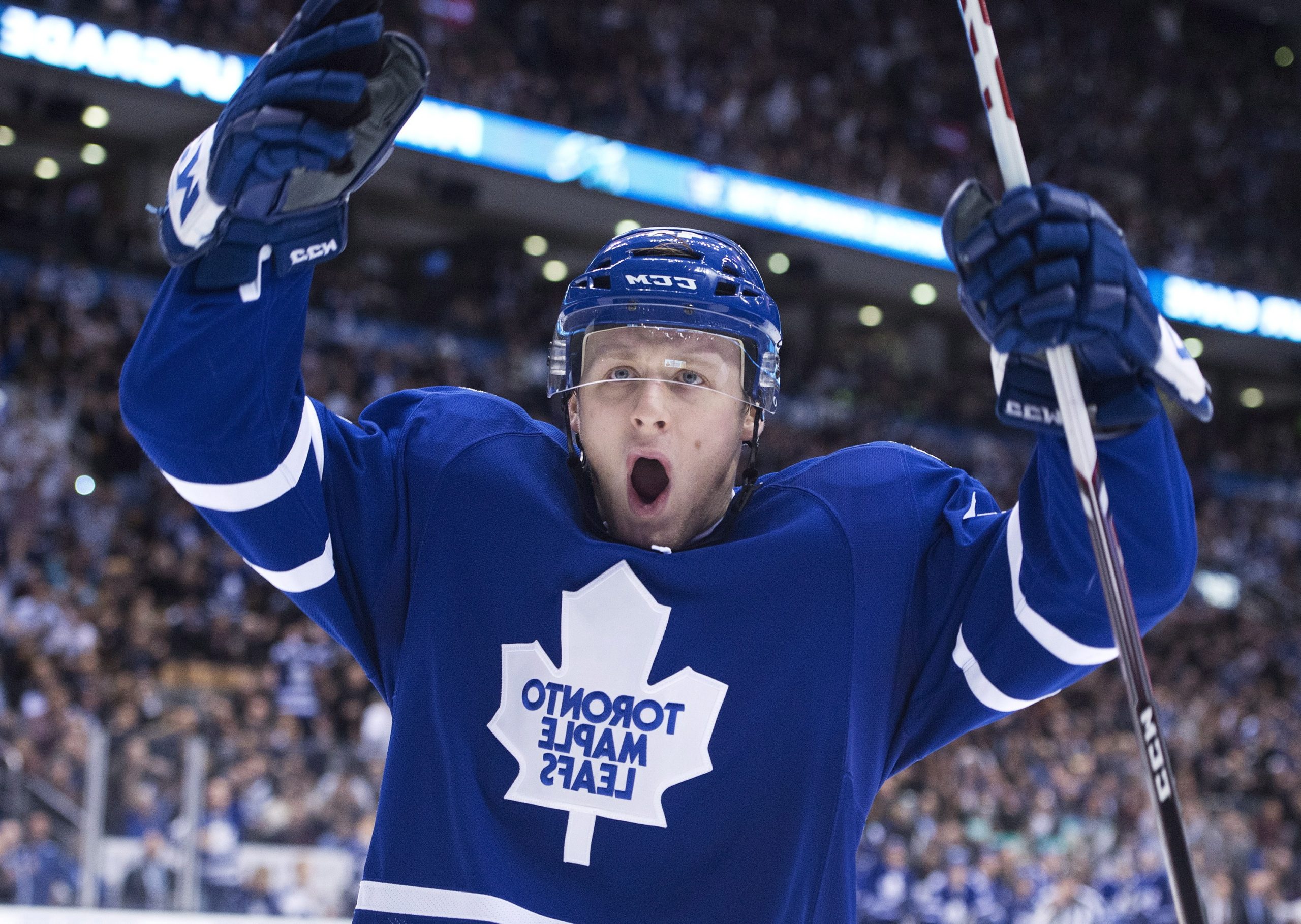Declan Kerin and Anthony Petrielli contributed to this report.
Defencemen
Morgan Rielly: B+
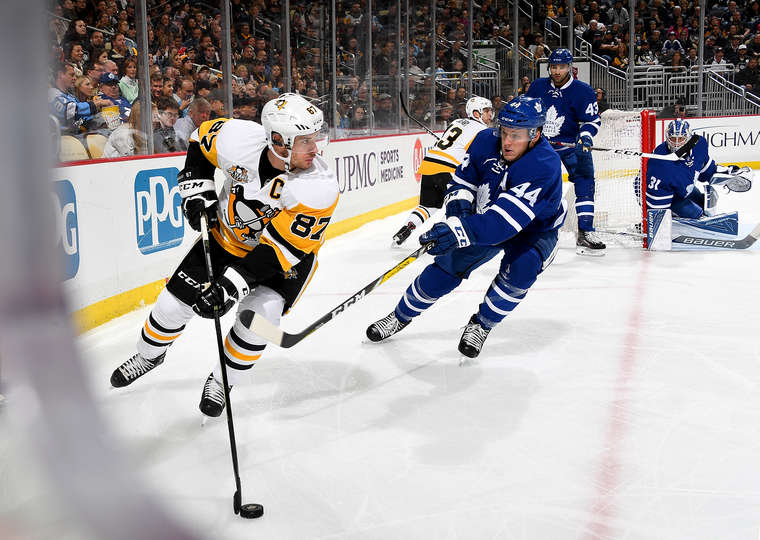
| GP | G | A | PTS | +/- | PIM | EV | PP | SH | GW | S | S% | ATOI |
|---|---|---|---|---|---|---|---|---|---|---|---|---|
| 23 | 1 | 11 | 12 | -6 | 7 | 10 | 2 | 0 | 0 | 46 | 2.2 | 22:55 |
Mostly dismissed as a classic Brian Burke-ism at the time, the former Leafs GM labelled Morgan Rielly “the best player in the draft” after selecting him fifth overall in 2012. Going on five years later, with first overall selection Nail Yakupov looking like a bust so far, it’s a debate between Rielly, Alex Galchenyuk, Hampus Lindholm and Filip Forsberg for top of the ‘12 class. Rielly has established himself as talented enough to be a top pairing defenceman in the NHL for the next decade or more.
Now 22 years of age, Rielly leads the Leafs in ice time at 22:54 a night this season and currently paces the Leafs defence with 12 points in 23 games (a 43-point pace over 82). Ten of those points have come at even strength, where Rielly is tied for eighth in point scoring among NHL defencemen. A one-man zone exit/zone entry, Rielly drives offensive opportunity for his team at a very high level. The Leafs are currently generating a shots for per 60 rate of 34.95 with Rielly on the ice — tops on the Leafs blue line and fifth in the entire NHL among defencemen with more than 100 minutes played this season.
His production at even strength is in stark contrast to his powerplay production, where Rielly is tied for 56th among defencemen with two points in 23 games (he is tied for 62nd in PP points since the start of 2015-16 with 10). It is mostly a matter of opportunity. Since he entered the league, Rielly has received relatively few powerplay minutes for a defenceman with his skill set (2:00 per game since 2013-14, trailing off in the past two seasons). His 1:21 PP TOI per game ranks him 82nd in the league this season out of the 170 defencemen with 15 or more games played.
Up until last season, part of the reason for the lack of powerplay time was the presence of Dion Phaneuf — who wore the C and had a big contract to live up to — logging major minutes on the man advantage and part of it was Rielly’s need to develop a better shot. Now it’s about learning how to defend properly, according to head coach Mike Babcock, who has admitted he has put the reins on Rielly in terms of rushing the puck and playing on the man advantage. Babcock believes that the short-term sacrifice as far as production is going to pay off in the long run, with the end goal of developing a top-pair stud who can produce offensively while shutting down the best players in the world.
Whether or not we agree that Rielly can’t do both at the same time, it is hard to disagree with Babcock on the point that Rielly’s defensive game could use improvement. Since the start of 2015, when Rielly moved into a top pair role full time, Rielly’s shots against per 60 and goals against per 60 rates are the worst among the Leafs’ regular defencemen (33.3 and 3.01, respectively). Some of that is due to a lack of a suitable partner last season, when he shared 735 even strength minutes with Matt Hunwick, but the defensive stats haven’t improved this season with a more capable partner in rookie Nikita Zaitsev (Rielly is allowing 3.5 goals against per 60 — worse than last season — and a marginally-improved-but-still-poor 32.91 shots against per 60), even though his overall possession numbers have shot up with more talent around him.
One area that is a work in progress for Rielly defensively is his stick detail through the neutral and defensive zones. He generally has two hands on his stick, which can pose two problems: 1.) His stick is often waist high and therefore not in passing and shooting lanes, nor is it discouraging passes and shots; 2.) It limits his range for a poke/sweep check. The result is that he’s not as effective as he could be at disrupting passes and plays before they develop into a shot or a scoring chance against.
Using the Leon Draisaitl’s rush versus Edmonton this week as an example, Rielly pivots and physically engages while pacing alongside the Oilers forward, but he doesn’t get his stick on the puck until it becomes a desperation play at the last moment. If he misses there, it could result, at a minimum, in a shot against — and possibly a rebound off the outside pad —or, in the worst-case scenario, a short-side goal. As Draisaitl entered the offensive zone, there was an opportunity for Rielly to reach inside and keep his stick blade in a shooting or passing lane as he tracked him to the net (Nikita Zaitsev and Roman Polak are both effective at this).
The McDavid goal against was mainly caused by Tyler Bozak not getting the puck deep at the offensive blue line as a line change was happening, creating the free path for McDavid. But watch as Rielly engages McDavid, throwing his weight forward with both hands locked on his stick; if he were to engage with one hand and stay on his feet, he would at least have some chance of making contact with the shaft of McDavid’s stick, or of adjusting and making a last-ditch play as McDavid makes his final move.
Another area Rielly can improve on defensively is when engaging a player on the cycle, where he doesn’t get inside on his opponents hard enough. For a player with his high degree of lower body strength, Rielly’s play on the wall is not as good as it could be.
These are areas that Rielly, as an intelligent player, should continue to improve in over time. He has the athletic ability in spades, but he’s still developing his bag of tricks.
Nikita Zaitsev: B+
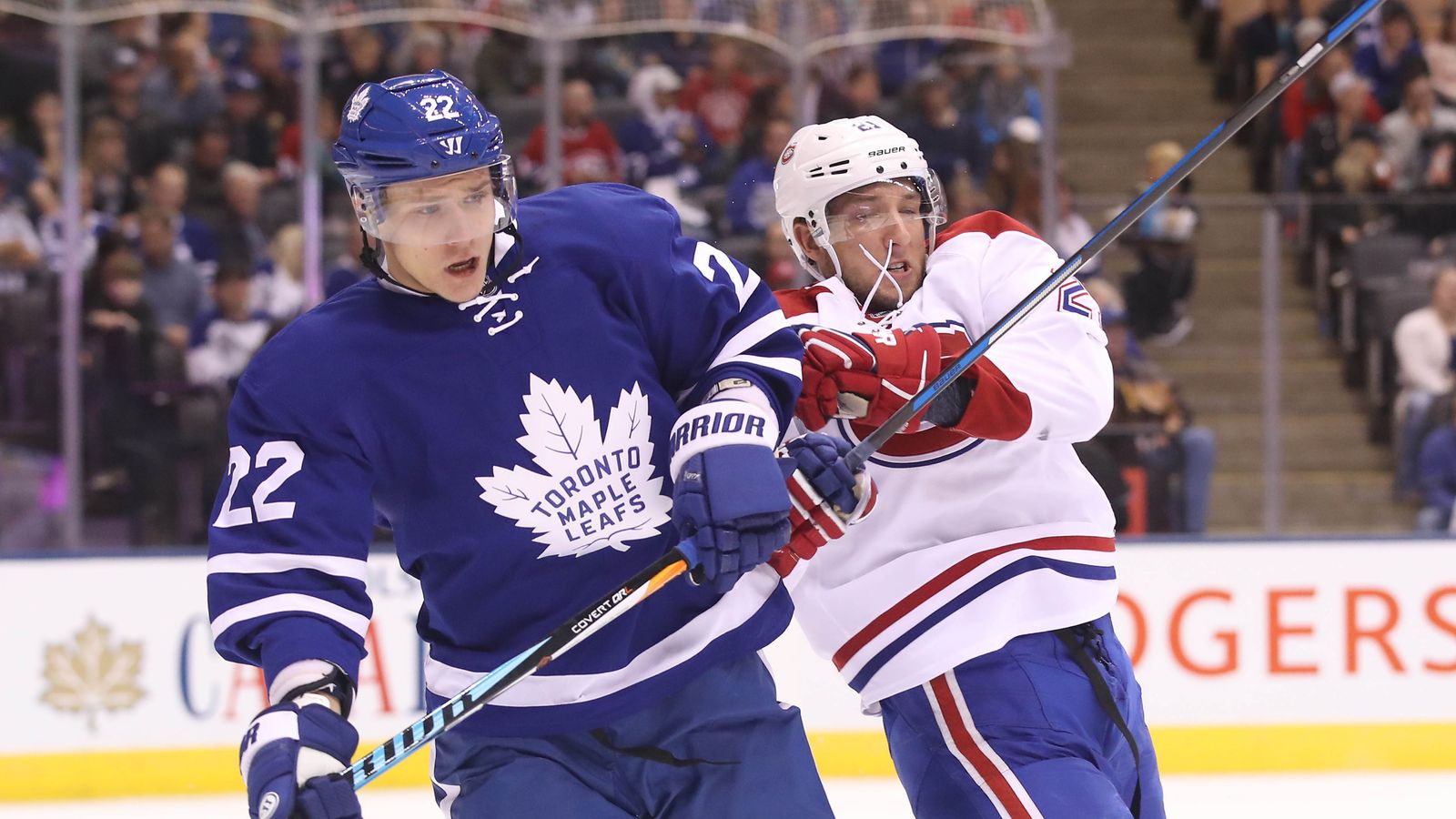
| GP | G | A | PTS | +/- | PIM | EV | PP | SH | GW | S | S% | ATOI |
|---|---|---|---|---|---|---|---|---|---|---|---|---|
| 23 | 0 | 9 | 9 | -8 | 6 | 7 | 2 | 0 | 0 | 31 | 0 | 21:59 |
You never know what to expect from a 24-year-old (now 25) undrafted free agent signing out of Europe, but Zaitsev has met and exceeded what could reasonably be expected of him 23 games into his NHL career. He’s a player who probably benefited more than most from the World Cup of Hockey; it gave him a chance to get over onto the North American ice surface and go head-to-head against the best players in the world in a top pairing role.
Zaitsev is second on the Leafs in ice time per game (22:54) and is tied for second with Jake Gardiner in point production with nine points, all assists. While a 48.8% Corsi For when paired with Rielly isn’t outstanding by any means — nor did he have a high bar to clear given who Rielly played with last season — to the eye Zaitsev has added a measure of stability to the top pair.
Good stick detail and his strength as a backwards skater allow him to maintain tight gaps against attacking forwards off the rush. Solidly built, Zaitsev commands his share of the ice. He’s effective when engaging an opponent on the cycle, using good technique — one hand on the shoulder pushing the player off balance while the free arm reaches in to poke or sweep the puck off the opponent’s stick. Even if he isn’t reaching the opponent’s blade, he’s constantly battling, pushing and reaching inside to disrupt. Zaitsev doesn’t throw bone-rattling hits, but he will stand players up at the blue lines and holds his own down low in the defensive zone.
He’s a rookie in name only as a 25-year-old with seven years of pro experience in the KHL, but his nine points place him third in rookie defence scoring and put him on pace for 29 over a full 82. Somewhat surprisingly, Zaitsev is yet to score a goal as an NHLer. We’ve seen the video highlight packages showcasing his big right-handed shot over in the KHL, but it hasn’t been much of a factor yet with 31 shots on goal in 23 games. That could have a fair bit to do with Zaitsev still adjusting to the league — in an unforgiving role, to boot. He may well have more to give there going forward.
Jake Gardiner: B+
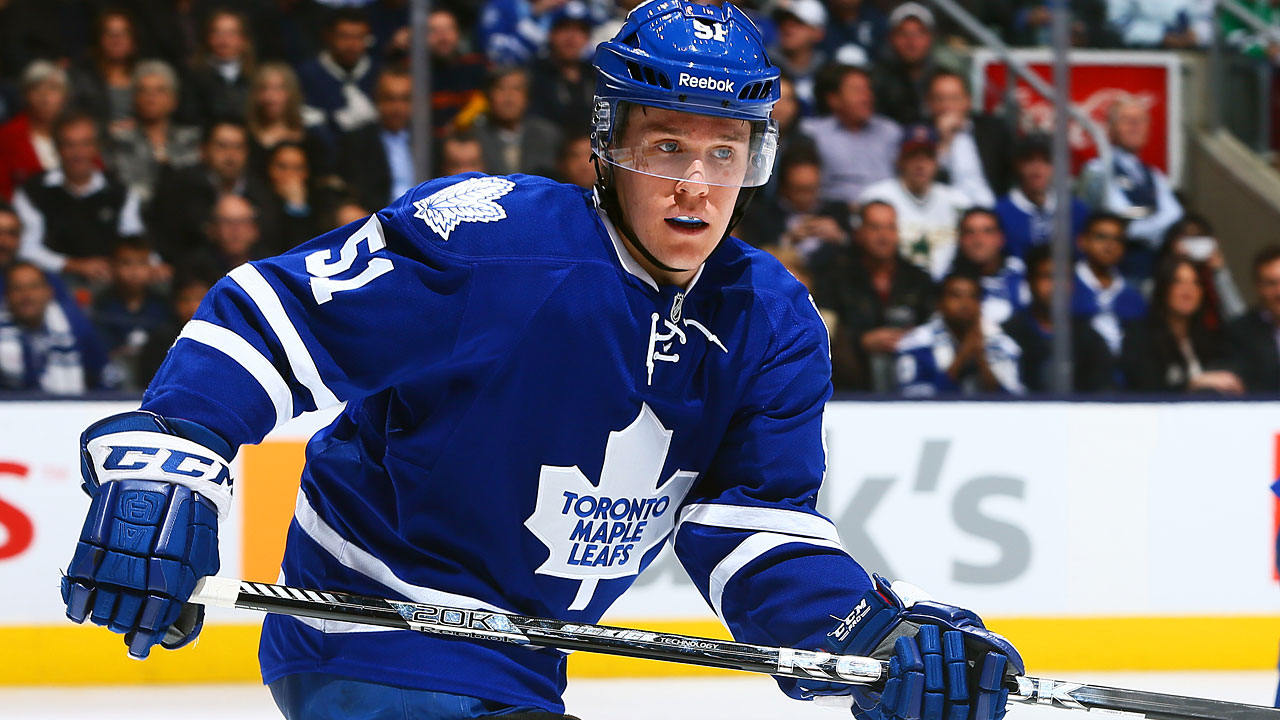
| GP | G | A | PTS | +/- | PIM | EV | PP | SH | GW | S | S% | ATOI |
|---|---|---|---|---|---|---|---|---|---|---|---|---|
| 23 | 4 | 5 | 9 | 3 | 10 | 7 | 2 | 0 | 0 | 33 | 12.1 | 19:45 |
Now 26 years old with 348 NHL games on his resume, Jake Gardiner has settled in as a quality NHL defenseman. Mike Babcock pegged him as a good second pairing defenseman last season, and that’s about how the coaching staff has used him so far this season. He’s third on the team in average ice time per game; his even strength ice time has fluctuated between third, fourth or fifth among Leafs defensemen, and he’s been the top-unit powerplay quarterback this season. Gardiner has bounced around between playing with Connor Carrick (170 minutes) and Roman Polak (130) at 5v5, playing very little with the rest of the defence group. On the season, the Leafs are generating over 53 percent of the shot attempts when he is on the ice — 56.6 percent with Carrick, 49.6 percent with Polak.
Considering he was given the keys as the top powerplay QB, nine points in 23 games (only two of them on the PP) is a little underwhelming. His overall play for $4.25 million is great value, though, and he seems to be a favourite of the coach. Just last week, Babcock gave Gardiner a raving review.
He’s just getting better and better. I always thought before that going to get the puck was an issue and playing defence was an issue. That’s not a problem for him at all. He spends a lot of time making good plays. Once in awhile, he can be lackadaisical, so we remind him of that. He’s a laidback guy. He’s got to get dialled in to play, but he’s a good, good player and he’s getting better all the time.
– Mike Babcock, November 26, 2016
For a player who is often panned for his weak defensive play, Jake Gardiner’s underlying stats show that he has again been an effective shot suppressor so far this season (30.7 shots against per 60 is second on the Leafs defence behind Connor Carrick); a big reason for Gardiner’s success in this area is that he often has one hand on his stick poking, sweeping, and getting his stick blade on pucks. Watching Gardiner occasionally get beat out of the corner with one hand on his stick isn’t pretty, but it’s also part of what makes him successful at suppressing shots.
Connor Carrick: B-
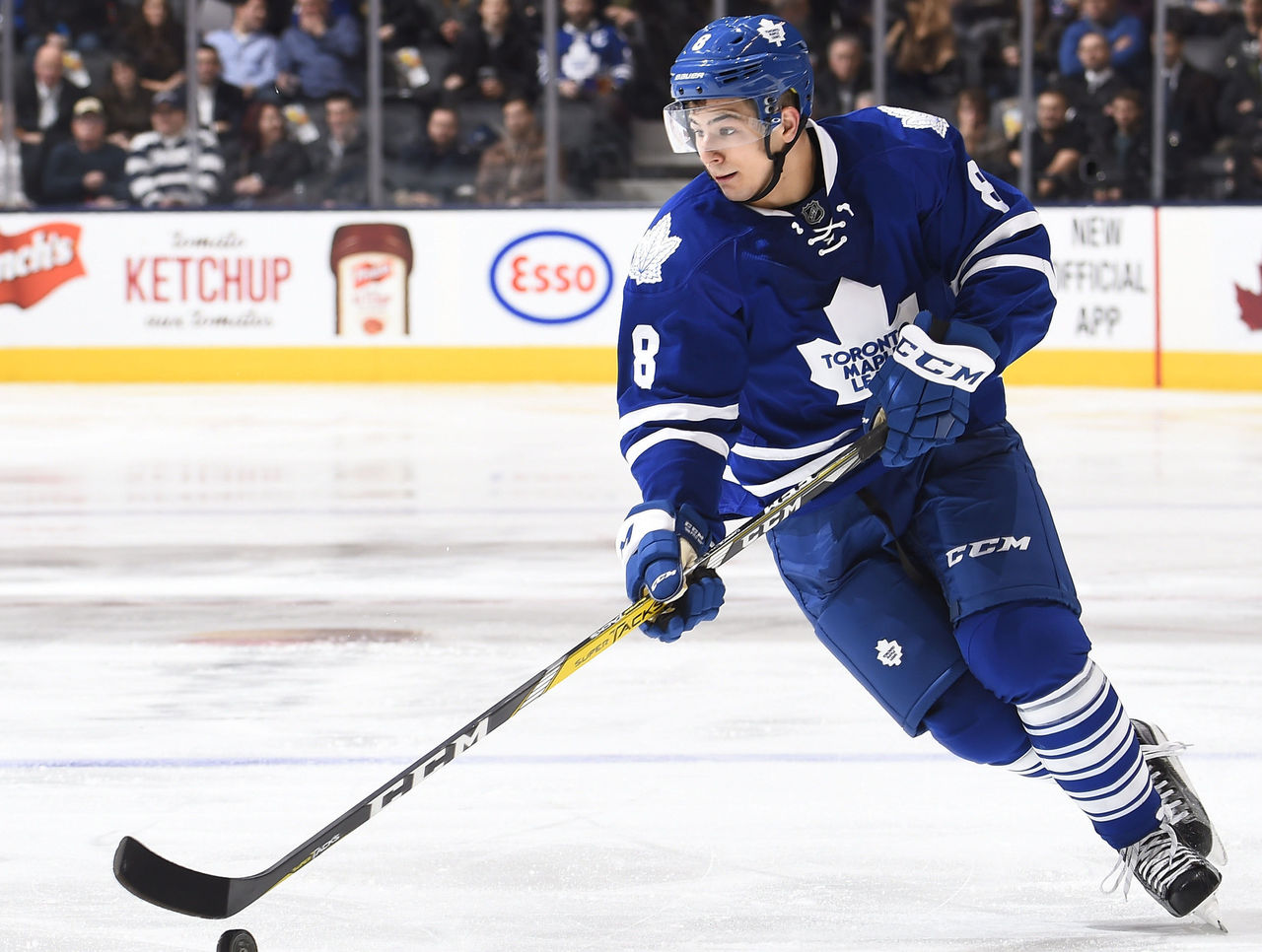
| GP | G | A | PTS | +/- | PIM | EV | PP | SH | GW | S | S% | ATOI |
|---|---|---|---|---|---|---|---|---|---|---|---|---|
| 21 | 1 | 2 | 3 | 4 | 24 | 3 | 0 | 0 | 0 | 31 | 3.2 | 17:19 |
After dominating the AHL playoffs last Spring to the tune of 18 points in 15 games, Carrick, a coveted right-shot defenceman, was a question mark for most going into the 2016-17 season: Does he have top-four capabilities, or is he a one-way offensive defenceman destined for the bottom pair/6-7 duty?
We’ll start with areas for improvement: So far this season, Carrick has been scratched in two games (vs. PIT on Nov. 12 and vs. NSH on Nov. 15th) and the coaching staff has been reminding him to rely on his stick and smarts while defending as opposed to trying to play a big man’s game:
“The way you get at it: You practise hard, you get refreshed. The NHL schedule is a blur. If you can take the positive of being a healthy scratch — get rest — it can be a very useful tool to get guys to play better than what they were. I don’t like guys to read my mind. I tell them exactly what I’m thinking. I think Connor is a good player. He’s got to stay out of too many physical confrontations and use his skating and skill much more than he was. That’s the challenge for him. He’s a real good player. We like his upside.”
– Mike Babcock, November 16, 2016
After spending two games in the press box watching from above and thinking about his game, Carrick was re-inserted into the lineup against Florida.
“It wasn’t anything specific, it was more just remember the things we talked about in the past, you know what we expect of you, and you know what you expect of yourself, so just execute.”
– Connor Carrick, November 16, 2016
The production also hasn’t been there yet despite receiving some time on the powerplay. He ranks third among the defence group with 1:26 per game — ahead of Rielly in fourth — and he has yet to record a powerplay point. Three points in 21 games put Carrick on a pace for just 11 points over a full 82-game season.
However, while his boxscore stats are nothing to write home about yet, Carrick’s underlying stats are excellent — especially when paired with Jake Gardiner (unsurprisingly). His on-ice shot attempts per 60 ranks second on the team, narrowly behind Gardiner. He sends and receives passes well, holds and walks the line well, and gets his shots off quickly — all attributes that help his team direct pucks toward the opposition’s net.
Carrick also currently leads the team in shot attempt prevention. He aggressively gaps-up off the rush, maintaining close proximity to an oncoming opponent and wedging him off into the boards. That either forces the opposition to make a play they rather not make or it throws them out of sync while trying stay onside. In possession of the puck, an accurate and well-weighted breakout pass — usually flat and as hard or as soft as it needs to be — allows the forwards on the ice extra time to make a play. He’s also an underrated skater with reasonably quick feet, an elusive stride, and good hands that allow him to evade pressure and move the puck out of danger if there are no options available to him through a passing lane. Add it all up and Carrick usually helps his line spend less time in its own zone in a given game.
Where the team would like to see Carrick improve is in defending the critical areas of the ice and not losing his check off the cycle — a challenge for all undersized defencemen in the NHL. Carrick likely isn’t a top-four option for the Leafs long term if they have designs on contending, but he is performing admirably in spot duty on Gardiner’s right for the time being. It’s easy to forget that he is 22 and only has 37 career NHL games under his belt. He’s a mature player for his experience level and he will get better as the season and his career progress.
Roman Polak: C-
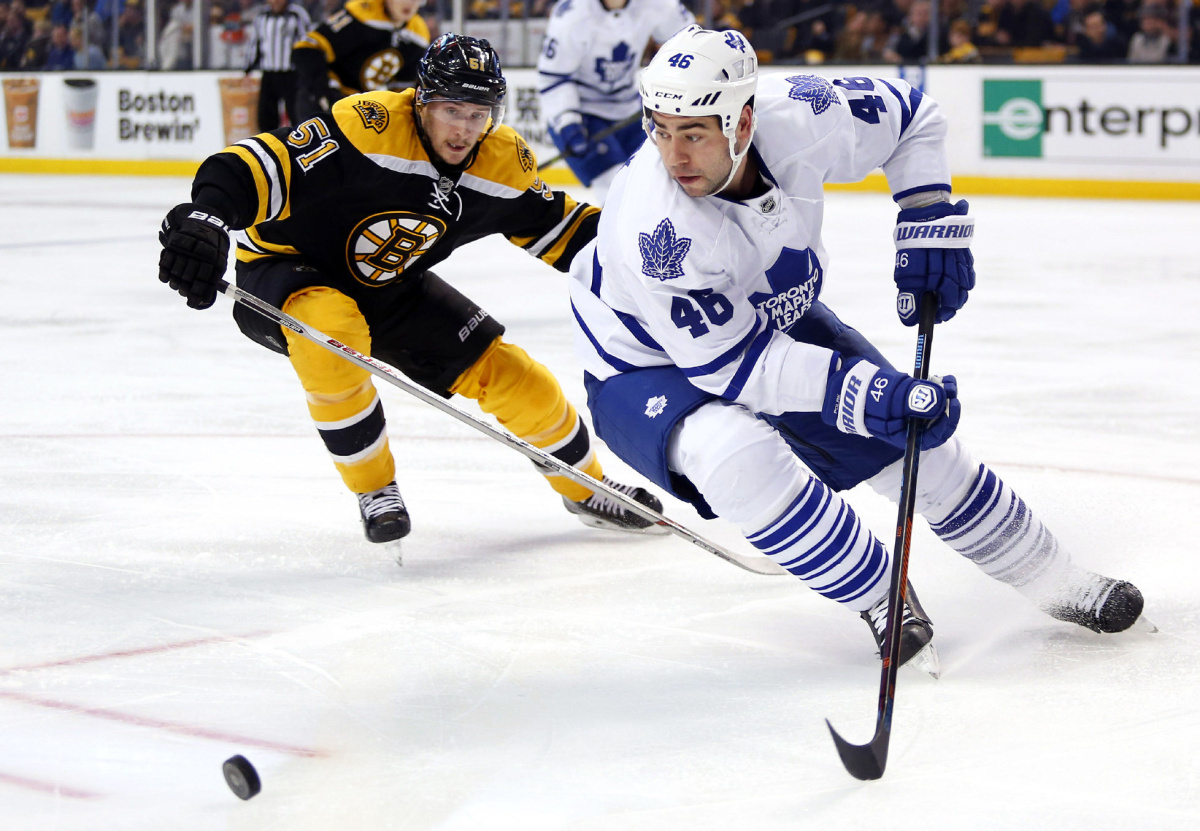
| GP | G | A | PTS | +/- | PIM | EV | PP | SH | GW | S | S% | ATOI |
|---|---|---|---|---|---|---|---|---|---|---|---|---|
| 18 | 1 | 1 | 2 | 0 | 17 | 2 | 0 | 0 | 0 | 12 | 8.3 | 17:44 |
Much like last October, he was a healthy scratch to start the season. The initial thinking was that Polak would be a regular scratch as the number-seven defenceman this season; as things progressed early in the year, Babcock didn’t like the mix on defence and Polak has seen regular ice time since (17:44 per night, 3:12 on the penalty kill). Derided in the advanced stats community (-7.2 CF% RELTM, lowest among Leafs defencemen), his ugly underlying numbers mesh with the eye test on many nights. Combined with poor defensive partners who can’t properly complement his limited skillset, Polak’s biggest difficulty lies in transitioning from defence to offence efficiently.
One area where he does excel is his ability to single-handedly stop the opposition’s cycle through getting inside on his opponents with a one-handed reach, along with his considerable strength in disrupting forwards if he can get even one hand on them. For Polak to succeed in a role as a play stopper, he needs to be paired with a “problem solver,” as Assistant General Manager Kyle Dubas likes to call them — in other words, a defenceman who can receive an awkward pass and either pass it, chip it, or skate it out of trouble. A pairing combination with Matt Hunwick or Martin Marincin (on his off-side) has made for some ugly nights at 5v5. Hunwick and Polak are a putrid 37.3% Corsi For in their 80 even strength minutes together.
Polak does receive a bit of a bump in his grade for playing over three minutes a game on a penalty kill that currently stands eighth in the NHL (84.9%). Like Hunwick, his goals against per 60 is flattering (2.08, 2nd among Leafs defencemen) and his 5v5 on-ice save percentage (94.12%) is tops on the team. The same debate from the Hunwick writeup below applies here.
Matt Hunwick: D
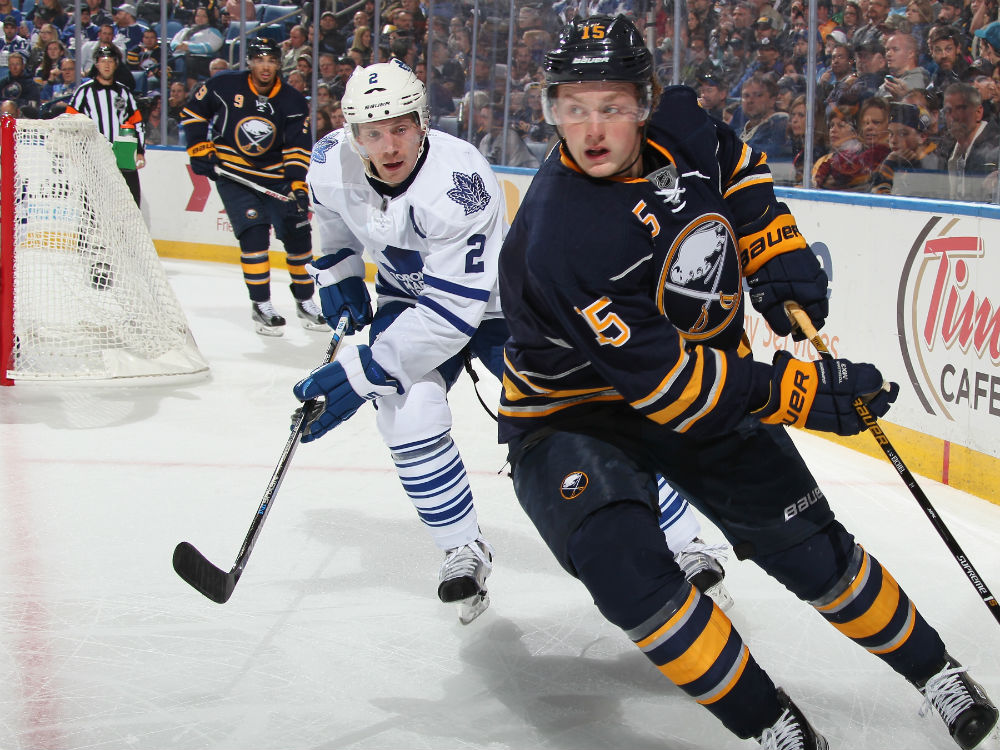
| GP | G | A | PTS | +/- | PIM | EV | PP | SH | GW | S | S% | ATOI |
|---|---|---|---|---|---|---|---|---|---|---|---|---|
| 15 | 0 | 4 | 4 | 3 | 2 | 4 | 0 | 0 | 0 | 16 | 0 | 17:47 |
While he started on the top pairing with Morgan Rielly last season and looked the part of a passable stopgap for a little while, as the 2015-16 season progressed he was getting filled-in in his own zone regularly up until his injury. Early in 2016-17, Hunwick has been widely considered the worst of the Leafs defencemen almost on a night in, night out basis.
Small in stature, not particularly strong or quick, limited in his puck skills along with questionable decision-making abilities, Hunwick appears to be in over his head most nights. He has had some flashes of usefulness — in his first night in the lineup after returning from injury versus Pittsburgh, he recorded three shots on goal and was pinching in from the points aggressively and at the right times. Overall, his confidence appears to have eroded to the point where he’s thinking more than playing, often looking like a deer in headlights against a heavy forecheck.
Hunwick’s minutes have been reduced this season (from 22:33 last season to 17:46 this season) and he is no longer receiving top-pairing deployment, but his possession results have not improved under lighter usage (-5.6 Corsi For relative to his teammates). He also contributes very little offensively: Among defencemen who have averaged over 20 minutes per game since the start of the 2015-16 season while appearing in 70 or more games, Hunwick is 89th of 95 in points per game (0.19).
He does sit atop the Leafs defence in goals against per 60 with a 1.95 so far while enjoying a combined on-ice save and shooting percentage of 104.5 (tops on the team by a fair margin). While he’s getting snowed under possession wise, it hasn’t translated into a negative goals share (he actually leads the Leafs with a 61.1 Goals For percentage). Perhaps Hunwick is doing something to positively influence his team’s save percentage when he’s on the ice (93.7%) that is not readily apparent through the eye test; maybe he’s simply been lucky in a small sample size; perhaps it’s down to playing against the other team’s checking lines most of the game; or maybe it’s a combination of more than one of the above factors.
Martin Marincin: D
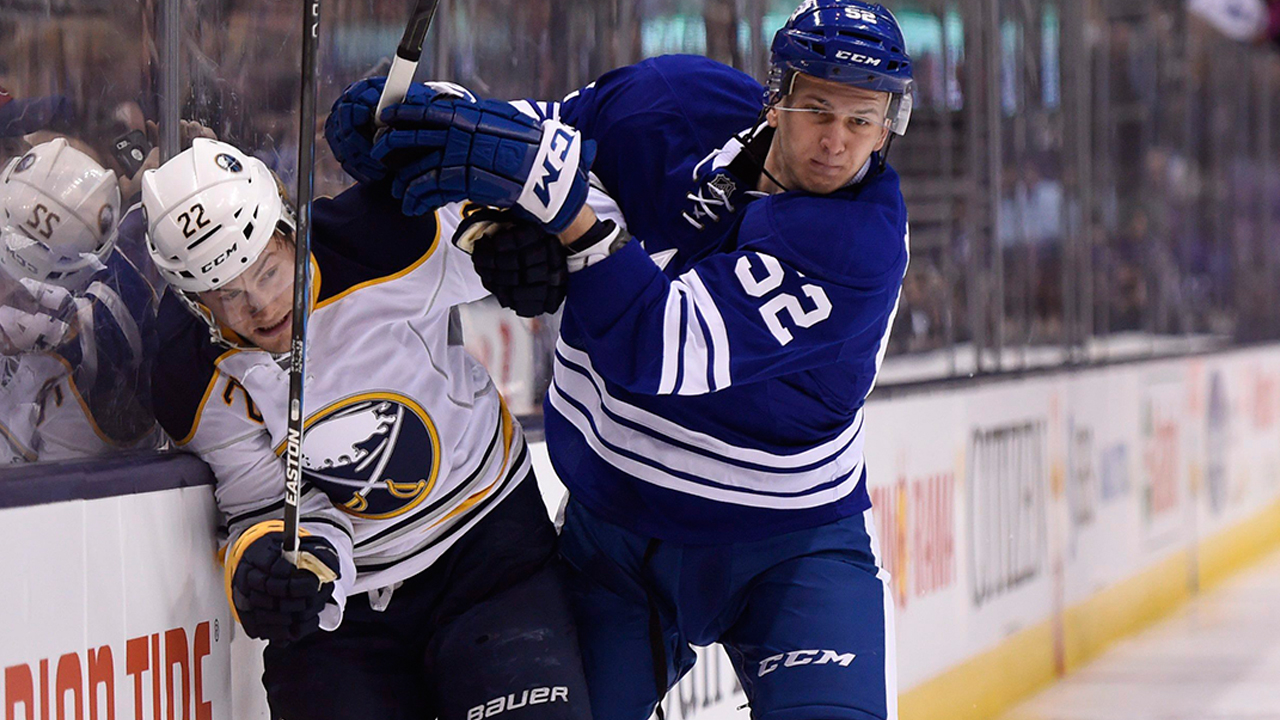
| GP | G | A | PTS | +/- | PIM | EV | PP | SH | GW | S | S% | ATOI |
|---|---|---|---|---|---|---|---|---|---|---|---|---|
| 14 | 1 | 3 | 4 | -2 | 4 | 4 | 0 | 0 | 0 | 13 | 7.7 | 18:59 |
After playing well down the stretch last season on a pairing with Morgan Rielly — and on his off-side, at that — Marincin has tumbled down the depth chart over the course of the first 23 games of 2016-17, struggling mightily on a number of nights. Mike Babcock has alluded to confidence issues with the 25-year-old defenceman; while it was slowly built up down the stretch of 2015-16, it’s eroding with each shift early on this season. Playing the off-side is the domain of highly-skilled players and the issues are amplified when paired next to Matt Hunwick. He’s spent too many shifts sucking dirty pond water while trying to dig pucks off the wall on his backhand, or receiving passes that he has to settle down and send up the wall.
An advanced stats darling in the past due to his ability to limit shots against — he has a great reach which he uses effectively to disrupt plays, and he maintains good gaps off the rush, limiting opponents’ ability to gain the zone — it remains to be seen if Marincin can turn his season around. It would help if he was paired with a partner he could build some chemistry with, but he’s not able to play even bottom pairing minutes well currently — minutes that are largely shared with a directionless fourth line that has a myriad of problems moving the puck. Most recently, Marincin played a season-low 11:17 against the New Jersey Devils after starting the season receiving top-four minutes (his season average now sits at 18:59/game). While he’s managed to string together three points in his last four games in between scratches, his possession numbers are down relative to last season (53.5% CF in 2015-16, 48.1% CF in 2016-17). His best results, like last season, have come alongside Morgan Rielly, with whom he’s managed a 51.7% CF over their 57 even strength minutes together. A healthy scratch in nine of 23 games so far, Marincin is looking more like expansion draft fodder than he is a part of the solution going forward on the Leafs blue line.
Goaltenders
Frederik Andersen: B+
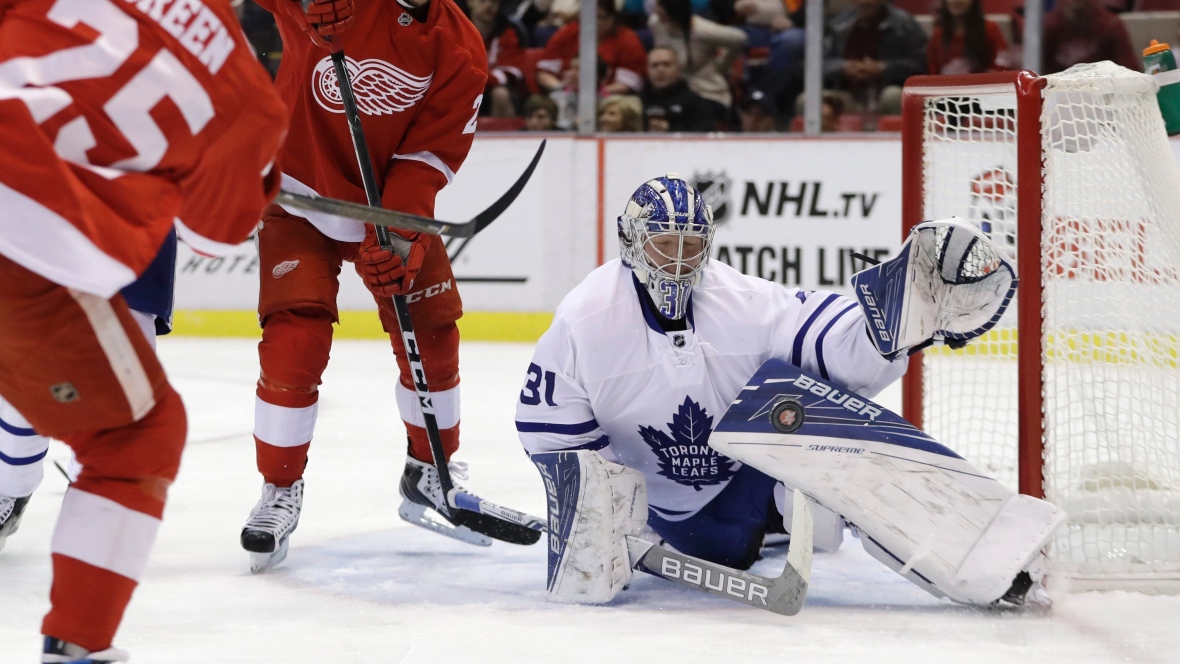
| GP | GS | W | L | T/O | SV% | GAA | SO | QS | QS% |
|---|---|---|---|---|---|---|---|---|---|
| 19 | 19 | 10 | 6 | 3 | 0.912 | 2.92 | 0 | 12 | 0.632 |
A start from hell in which it appeared everything that could go wrong did go wrong saw Andersen put up a 1-1-3 record with a miserable .851 save percentage over his first five games. The excuse at the ready was the injury he suffered in Olympic qualifiers in early September that limited his training camp and preseason participation, combined with the adjustments involved with joining a new team, learning new systems, new teammate tendencies, and working with a new goalie coach in Steve Briere. That appears to have been a totally valid excuse in hindsight. It was also assumed — although not admitted by either Babcock or Andersen himself — that he was asked to be more aggressive challenging shooters based on James Reimer’s feedback about Babcock’s system last season. That seemingly led to some early issues with Andersen’s depth and ability to get set in his net which have since been remedied.
Since a particularly ugly seven-goal loss to the Tampa Bay Lightning on October 25th, Andersen has found his game, going 9-5-0 with a .932 save percentage (eighth in the league since October 27th among goalies with 10 or more games played in that span). The big, calm, economical goaltender with above-average puck-handling skills that the Leafs and their fans thought they were getting in the summer has shone through of late. He’s allowed two goals or less in each of his last six starts and looks like he’ll be able to provide above-average goaltending from here on out, health permitting.
With Andersen on form, the Maple Leafs have been more or less in every game. Observers of the team will sit with arms folded as they wait to see if the big Dane can bring the consistency and durability required to be a true starting goalie in the NHL; he’ll need to prove he can play 60-65 games capably as their starter, and may be leaned on especially hard considering the slow start from Jhonas Enroth. It’s far too early to say, but the fact that he experienced his first controversy in the Toronto market and came out on the other side provides some hope that Andersen could have the mental game to survive where many Leaf goalies have failed over the past ten years.
Jhonas Enroth: D
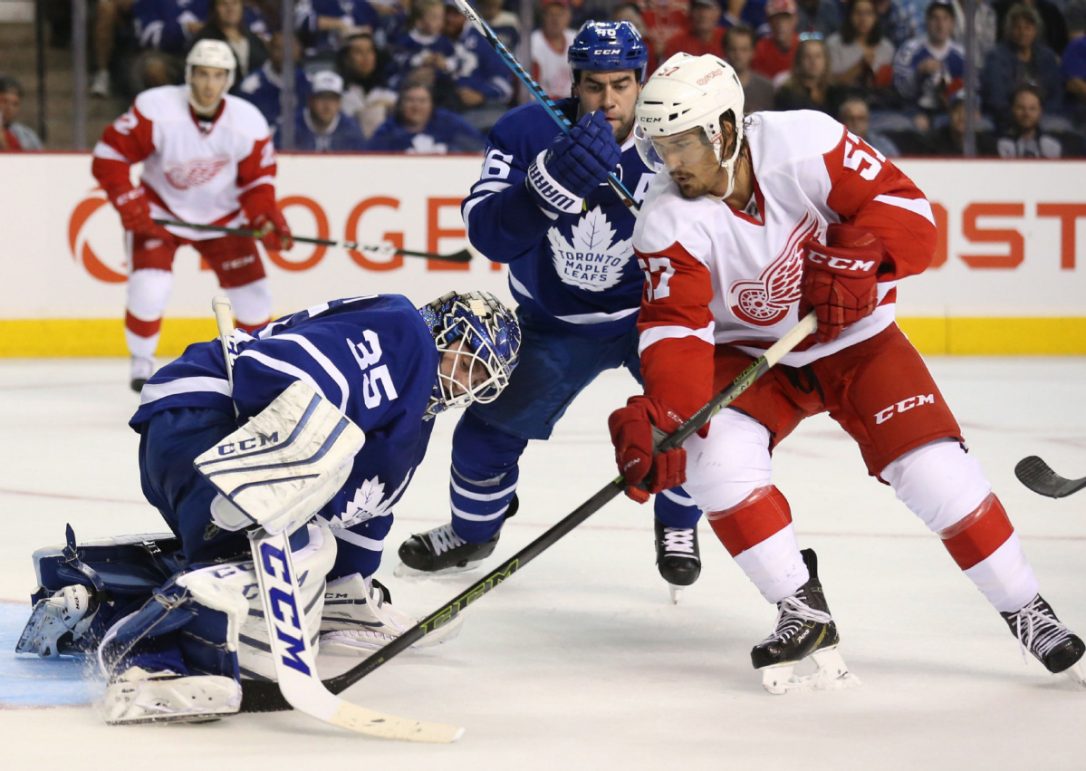
| GP | GS | W | L | T/O | SV% | GAA | SO | QS | QS% |
|---|---|---|---|---|---|---|---|---|---|
| 6 | 4 | 0 | 3 | 1 | 0.872 | 3.94 | 0 | 0 | 0 |
Playing your way out of a funk as a backup goaltender can be tough when the starts are sparse and only come in back-to-back situations, but spot duty is part of the job description and Enroth hasn’t made enough saves. The Leafs are 0-4-1 as the tired team so far this season, with Enroth starting four of the five. Some lame efforts from the team in front of him has played its part, but Enroth is 51st of 54 in save percentage among NHL goalies with five or more games played (.872).
While he managed to regain his composure in the final two periods in Calgary, giving up three in the first period to the 29th-best offence felt like rock bottom. It’s been pointed out many times over that Karri Ramo has been lurking in the background, taking part in Leafs practices while rehabbing his knee. The fact that Enroth is the smallest goalie in the league at 70 inches and 175 pounds likely doesn’t buy him any extra leeway from a coach that heavily favours size at the position.
Enroth’s career numbers — particularly his quality start percentage, which is a measure of how often a goaltender provides league average or better goaltending — looked promising coming into the year. Leafs management also liked that Enroth readily accepted his role as a backup goalie as opposed to one intent on splitting starts or wrestling the crease away from newly-appointed number-one Frederik Andersen. There is certainly no concern about that 23 games into the season, but there might be competition for number two on the goalie depth chart before long if Enroth’s slump lasts much longer.























